-
June 19, 2019 by Total Fire and Safety
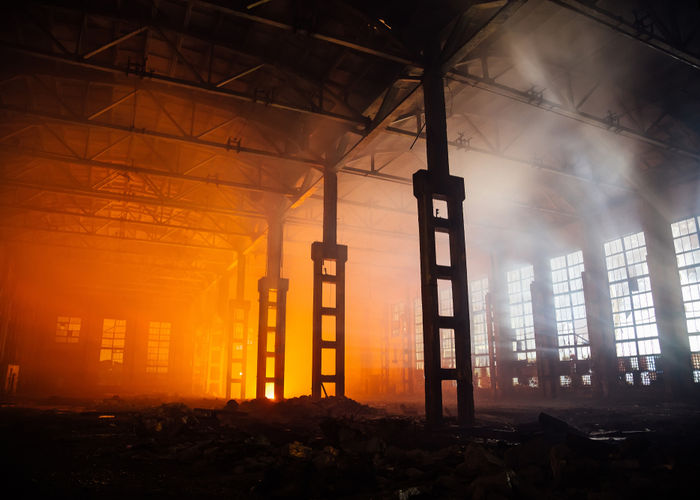
According to legend, the cause of the greatest fire in Chicago was a cow kicking over a lantern in a barn. In 1871, the entire city of Chicago was engulfed in flames. The fire lasted two days, left 300 people dead and over $200 million in damage. The event changed Chicago. Stricter fire codes were implemented, structures were built with different materials, and fire departments were equipped with better equipment and advanced training methods.
Today, fires in Chicago rarely go unexplained due to investigative divisions within the fire departments. The investigative teams are well trained in how to identify common causes of fires in Chicago. The most common causes of fires in Chicago vary by type.
Common Causes of Residential Fires
- Overusing extension cords
- Overusing Christmas lights/stringing them together under furniture
- Smoking materials (cigarettes, cigars, etc.…)
- Heating or electrical malfunction
- Cooking or kitchen fires
Common Causes of Industrial Fires
- Combustible dust
- Hot work
- Flammable gas or liquid
- Equipment and machinery fires
- Electrical hazard fires
How Fires are Investigated
Whether it is a residential fire or industrial fire, criminal or accidental, fires in Chicago and around the country all have a determining factor. The responsibility for finding the determining factor is up to the fire department. From a public standpoint, finding a cause seems impossible. How do they do it?
Upon arriving at the scene, firefighters note the color of the flames, the amount of smoke, the rate at which the fire spreads, and the sound it makes. These are all clues as to what is burning and how it is burning. It is incumbent of the firefighters to protect the evidence at the scene by:
- Limiting excessive fire suppression
- Preventing needless destruction to a property
- Using markers or cones to identify evidence
- Writing notes or making voice recordings of observations
- Covering areas that contain evidence
- Preserve delicate evidence like shoe or tire tracks
Once the fire is extinguished, the fire investigators dig through the ashes. They take photographs prior to and during the investigation for documentation. The objective of investigators is to locate the point of origin. This is achieved through the char patterns, direction of melt, and heat shadows. The burn patterns are often “V” shaped like an inverted cone. The fire burns upward, in a V-shaped pattern away from point of origin. The location is usually the most damaged by the fire. Although most of the determination of origin is science-based, there is a little bit of guessing and witness accounts. Fires in Chicago are likely to have one of four reasons:
- Electrical issues
- Natural acts
- Open flames
- Human action
Fires in Chicago have decreased over the years with an average of eight fire per day. Fortunately, fatal fires are rare, but even one is too many. It’s important for residents and businesses to practice fire safety. Is your business well equipped against fires? Total Fire and Safety can help safeguard your building and those occupying it with fire alarms, fire extinguishers, first aid kits, emergency lights and more. We’ll inspect your property to ensure it is up to code and even provide training classes for employees so they know how to use the equipment in an emergency. Give TFS a call today at 630-960-5060.
Category: Business Safety, Fire Extinguishers, Fire News, Fire Safety Tags: commercial fire protection, commercial fire safety, fire and safety solutions, Fire Extinguisher, fireextinguisher, firesafetytraining | Comments Off on In the Aftermath: Finding the Causes of Fires in Chicago
-
April 24, 2019 by Total Fire and Safety
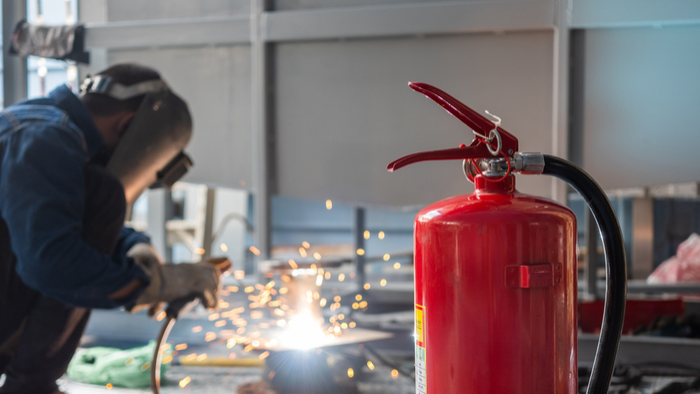
According to the National Fire Protection Agency (NFPA), between 2011 and 2015, there was an estimated 37,910 fires at industrial properties each year. These industrial fires resulted in 16 civilian deaths, 273 civilian injuries, and $1.2 billion in property damage.
Industrial fires are serious, but there are several things you can do at your plant or factory to minimize the possibility of an industrial fire. First, it’s important to know how they usually start.
The five most common causes of industrial fires are…
1. Combustible Dust Fires
A combustible dust is any dust or fine material that has the potential to catch fire and explode when it is mixed in the air. Many times, materials that are normally considered non-flammable can act as a combustible when fine particles are mixed with air in a particular concentration. Combustible dust happens in two waves. A primary explosion causes particles to become airborne, and then the dust cloud can ignite and cause a secondary explosion, much more severe than the first. Combustible dust can bring down entire facilities.
How do I Prevent Combustible Dust Fires?
- Implement a hazardous dust inspection, testing, housekeeping, and control program.
- Regularly inspect for dust residues in open and hidden areas.
- Use proper dust collection systems.
- If ignition sources are present, use cleaning methods that do not generate dust clouds.
- Control smoking, open flames, and sparks (mechanical and friction).
2. Hot Work Fires
Hot work is any activity that involves open flames or generates sparks or heat. This includes welding, heat treating, grinding, thawing pipes, torch cutting, brazing, soldering, etc. Hot work becomes a fire hazard when sparks and molten material travel…often as far as 35 feet, sometimes igniting combustible dust in other areas.
How do I Prevent Hot Work Fires?
- Train personnel on the hazards associated with hot work and make sure they are using proper safety equipment.
- Clear area of flammable materials including dust, gases, and liquids.
- Make sure a safety professional is on site to provide supervision of the work.
- Avoid hot work if possible.
3. Flammable Liquid and Gas Fires
These are most common in chemical plants. Flammable liquids and gases can ignite off sparks from the previous hazards or add fuel to an already burning fire.
How Do I Prevent A Flammable Gas Fire?
- Know the hazards of each flammable liquid and gas on-site. Read and follow the safety information for storage and follow the material safety data sheet included with the product.
- Properly store hazardous materials according to OSHA.
- Keep ignition sources away from flammable gases and liquids.
- Provide personal protective equipment, like gloves, bodysuits, vests, goggles, shoes etc.
4. Equipment and Machinery Fires
Equipment not properly installed, maintained, or operated correctly is a major cause of industrial fires. This is especially true for equipment associated with hot work and heating. Even machinery not seen as a fire hazard can become a risk with lack of proper maintenance.
How Do I Prevent Equipment and Machinery Fires?
- Training can help employers and employees identify possible risks and what to do if they find one.
- Keep the machines, equipment, and areas surrounding them, clean.
- Prevent machine overheating by following the manufacturer’s guidelines for recommended maintenance procedures.
5. Electrical Hazard Fires
Electrical fires are most common in manufacturing plants and include wiring that is exposed or not up to code, overloaded outlets, extension cords, overloaded circuits, static discharge, etc. A spark from electrical hazards can cause ignition of combustible dust and flammable liquids and gases.
How Do I Prevent Electrical Hazard Fires?
- Don’t overload electrical equipment or circuits.
- Unplug temporary equipment not in use.
- Avoid using extension cords.
- Use antistatic equipment as advised by OSHA and NFPA.
- Follow a regular cleaning schedule to ensure combustible dust and other hazardous materials are removed from areas that house equipment and machinery.
It can seem overwhelming to have to safeguard your facility against industrial fire hazards, but the pros at Total Fire and Safety can help you identify and prevent risks throughout your facility. They also provide fire safety training to educate employees on proper fire safety equipment operation and life safety procedures.
To take the first step in keeping industrial fires at bay at your facility, call Total Fire and Safety at 630-960-5060 or reach us at our 24/7 emergency line, 630-546-8909.
Category: Business Safety, Fire Safety, NFPA Compliance Tags: commercial fire protection, commercial fire safety, fire and safety solutions, fire safety training, Industrial Fire Prevention, Industrial Fire Safety, Total Fire & Safety | Comments Off on The Best Way to Prevent Industrial Fires
-
March 22, 2019 by Total Fire and Safety
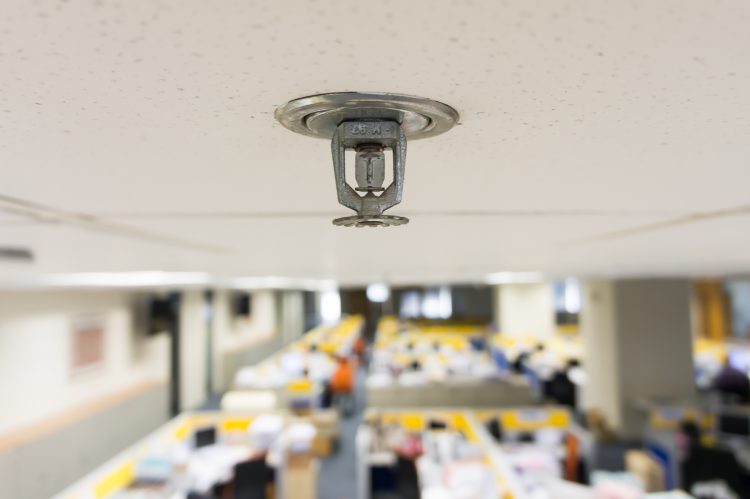
In a commercial building, a fire sprinkler system is one of the most effective ways to control and extinguish fires. A well maintained fire sprinkler system can mean the difference between minor damage and total destruction.
A fire sprinkler system is a group of pipes and sprinkler heads located on ceilings or overhead. They slow the spread of fire or extinguish fire by releasing a spray of water. They are designed to cover as much area as possible to provide widespread coverage.
Most fire sprinklers are heat activated. When heat is detected, water is released and the fire alarm will likely be activated. Obviously, we need fire sprinklers to be as reliable as possible. So when and why do they fail?
The NFPA reports that there are an average of 660 reported sprinkler failures a year. However, with a proper working fire sprinkler 96% of the time they are effective in controlling most fires. The most common causes of sprinkler failures are:
- System shut-off
- Manual intervention
- Damaged components of fire sprinklers
- Lack of maintenance
- Inappropriate design of the fire sprinkler systems
Fortunately, most of these problems can be alleviated with proper, regular inspection of your fire sprinkler system by a trained professional. The NFPA suggests different intervals per year in order to ensure effectiveness.
Monthly inspection should ensure that
- Valves are accessible, labeled properly and are not leaking
- Wet gauges should be in good condition with proper water pressure detected
- Dry gauges should have normal water pressure with the quick opening device showing the same pressure as the dry pipe valve
Quarterly inspection should:
- Check for physical damage to the supervisory alarm and water flow alarm
- Dry test the system to check for valve issues
- Check that all fire department connections are accessible
- Check for leaks around the fire department connections
- Inspect pressure reducing valves (free of leaks, open position, maintaining downstream pressure)
Annual inspection should include all of the above, plus professional inspection by a certified professional for code compliance and tagging.
Well-maintained fire sprinkler systems are paramount to your building safety and occupants. The professional at Total Fire and Safety is dedicated to keeping you safe and in code compliance. Give us a call today to schedule an inspection at 630-960-5060.
Category: Business Safety, Fire Safety, Sprinkler Systems, Total Fire and Safety Tags: commercial fire safety, commercialfiresprinkler, fire safety, Firesprinkler, firesprinklerinspections, sprinkler, sprinklerinspections | Comments Off on Will your fire sprinkler system work when the heat is on?
-
February 27, 2019 by Total Fire and Safety
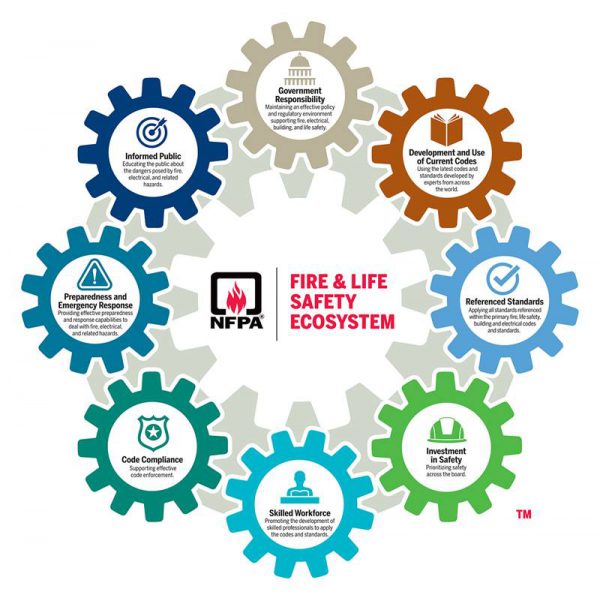 Image: NFPA Website The fire and life safety ecosystem led the discussion at the 2018 NFPA Conference and Expo. What is the fire and life safety ecosystem? Like any ecosystem, it is comprised of elements that work together to achieve a functioning system—in this case, eight separate elements that have to do with fire and safety. Several of them are the responsibility of the government, while many call upon the public to enforce and deliver. Regardless of who is charged with the responsibility, the goal throughout the ecosystem is to prevent major disasters from fire, electrical, and other hazards. When tragedies occur, it is likely there was a breakdown in one or more parts of the fire and life safety ecosystem. Here are the eight components relating to the fire and life safety code:
- Government Responsibility: Policy makers must maintain effective policy and regulatory environment and not prioritize politics over the public’s safety. When life safety codes are stripped for any reason, people’s lives are endangered for the sake of political gain.
- Development and Use of Current Codes: Government and building designers must implement the latest codes and standards or risk losing the latest technology and research in fire, electrical, life safety.
- Referenced Standards: All standards within the fire, life, building, safety, and electrical codes must be addressed or the right products and practices will not be used, possibly leading to disastrous results.
- Investment in Safety: Property managers and need to make an investment in safety to comply with the latest standards and codes. Hiring a company like Total Fire and Safety means an investment in safety. All the latest fire safety technologies are always available from TFS and we can design a program to fit any company’s needs and budget.
- Skilled Workforce: Promote the development of skilled professionals to apply the codes and standards. For over 20 years, TFS has employed highly skilled, highly trained, and highly dedicated workers in order to put customers’ safety above all else.
- Code Compliance: Effective code enforcement is necessary. Fire Marshalls and other officers must conduct regular inspections to ensure safety and code compliance.
- Preparedness and Emergency Response: Provide effective preparedness and emergency response capabilities to deal with fire, electrical, and related hazards. Train employees on emergency equipment, fire safety drills, designated leader in emergencies, etc.. TFS provides training classes for employees, as well as, informative literature on how to react in an emergency and much more.
- Informed Public: Educating the public is important, as is educating businesses about the specific fire hazards in their facilities.
No one cog in the fire and life safety ecosystem can keep us all safe from harm. Even all the pieces together, working in tandem, may not prevent every disaster, but they can certainly prevent many. By practicing and implementing the various areas outlined in the fire and life safety ecosystem, we can all create a safer community. At Total Fire and Safety, we are committed to helping you play your role in the fire and life safety ecosystem. Contact us today to discuss your fire safety needs or call 630-960-5060.
Category: Business Safety, Fire code violation, Fire Safety, Health and Safety, NFPA Compliance, Total Fire and Safety Tags: fire and safety equipment, fire and safety needs, fire and safety solutions, fire safety solution, fire safety training, Total Fire and Safety | Comments Off on What’s a Fire and Life Safety Ecosystem?
-
January 23, 2019 by Total Fire and Safety

Commercial first aid kits don’t have to be costly. Yet, when you start to compare commercial first aid providers, you will see some radical differences in pricing. Many first aid service companies find creative ways to drive up costs for their customers. At Total Fire & Safety, our customers never have to worry about “hidden costs” because there are none! Knowing what your company needs and being sure you are not paying for more can help your overall first aid budget and ensure you have the right first aid provider on your side. Here are some tips on hidden fees so you can avoid any surprise charges from your first aid service company.
- Make sure you know what is going in the box.
It is possible that you don’t need many of the supplies the service stocks in your cabinet. Depending on your workplace, employees can experience minor cuts etc. However, overstuffing a kit with odd size bandages and unnecessary items like hand lotion, lip ointment, dental cream, etc. helps a company justify a higher invoice. At Total Fire and Safety we stock what is required by OSHA and what is directed by the client. No redundant or unnecessary items.
- Make sure you are not getting charged extra for “normal” items.
Some companies charge extra for special items, like disinfectant wipes. Check your invoices! There are no surprises with TFS.
- Make sure you are not getting charged for additional representatives.
Some first aid companies have separate reps for stations, for example, first aid kits and eyewash stations. At TFS, your single representative is knowledgeable about all your first aid needs to streamline costs and deliver consistent quality service.
- Make sure the first aid service meets ANSI requirements.
ANSI (American National Standards Institute) puts together the requirements for first aid supplies in the workplace. They provide a specific list for first aid kits. A service company might overlook this list in order to stock a kit with many unnecessary various types of items. At Total Fire and Safety, we provide supplies required by ANSI as well as OSHA.
- Make sure you understand the fees on the invoice.
Do you see service or delivery charges, overstocking or restocking fees? First aid service companies pile these costs into an unreadable invoice. TFS does not charge service fees, fuel, or delivery charges. We only charge for items that employees have used. Have a question about the bill? TFS is there to answer any concerns.
There are many services companies in business to make a buck at the expense and well-being of your company. You should not have to choose between a safe work environment and a cheaper bill. TFS recognizes the importance of a healthy workplace combined with the affordability of superior service. TFS never overcharges, overstuffs, or places hidden fees with in a first aid kit. We provide the right supplies to keep employees safe at work while always keeping costs down. For more than 30 years, Total Fire and Safety has been providing OSHA approved first aid kits and replenishment to businesses. If we can help with your first aid needs, contact us today at 630-960-5060.
Category: Business Safety, First Aid, First Aid Kits, Total Fire and Safety Tags: fire and safety needs, fire safety, first aid, first aid supplies, Total Fire & Safety | Comments Off on Avoiding the Hidden Costs of Commercial First Aid Kits
-
December 4, 2018 by Total Fire and Safety

A brand new year is a great time for businesses to evaluate what they can improve upon, even in terms of their commercial fire safety. No business is completely immune to accidental fires and having the right equipment in place year round can prevent potential devastation.
According to the National Fire Protection Association (NFPA), more than 3,300 fires break out in office buildings across the U.S each year. The NFPA reports that a number of people are killed or injured with an estimated $112 million in property damage.
If you’re a business set on achieving your 2019 goal of reaching NFPA compliance, take a look at checklist of equipment you need below for commercial fire safety. Anything missing? Call Total Fire & Safety. We can help!
____ Alarms
____ Extinguishers and Suppression Systems
- Conduct tests regularly to ensure function and pressure when activated.
- Schedule routine maintenance of equipment.
- Store extinguishers in open areas for easy access.
____ Emergency Lighting
- Effective emergency lighting throughout the building will help occupants to safety in an emergency.
- Schedule regular maintenance and inspections.
Equipment is essential and necessary to prevent major damage but people are too! Whether it’s putting out a fire or tending to the injured, what good is the equipment if you don’t have employees able to use it?
____ First Aid
____ Training Courses
- A comprehensive fire equipment training course on the use of fire equipment and first aid can place confidence in employees and keep everyone safe.
- Training employees reduces the chance of small fires starting and spreading.
You could have all the equipment ready and employees trained to use it but they need something else.
____ Emergency Preparedness Plan
- Remind employees to REACT-(remove from danger, ensure doors/windows are closed, activate alarm, call 911, treat as dangerous.)
- Conduct fire drills.
- Schedule inspections of all fire equipment.
- Have employees trained on firefighting equipment.
Making sure you have commercial fire safety in place can seem a daunting task but the pros at Total Fire and Safety are here to simplify it. TFS covers everything including inspection, maintenance, training, and keeping your building up to code so you are well protected in the event of an unforeseen fire. Give us a call today at 630-960-5060.
Category: Business Safety, Fire Alarm Monitoring, Fire Equipment Inspections, Fire exits, Fire Extinguishers Tags: commercial fire protection, commercial fire safety, commercial first aid kit, emergency exit lights, emergency lighting, fire and safety solutions, Fire Extinguisher, fire safety, fire safety training, fireextinguisher, firesafetytraining, firesprinklerinspections, first aid | Comments Off on The Business Owner’s Checklist for Commercial Fire Safety in 2019
-
November 5, 2018 by Total Fire and Safety

Next to the everyday hustle and bustle of the average office, office kitchen fire safety is a secondary concern. However, the National Fire Protection Agency (NFPA) reports that just over one-fifth of office fires begin in the kitchen or cooking area. Twenty-nine percent are started by cooking equipment, the leading cause of fires in the office. Although these fires started small, they caused major structure damage.
With the holidays on the way and more employee parties sure to take place, the office kitchen will be used more than ever. How can you prevent a fire from happening? How do you keep your employees safe and well fed at the same time? Here are four important safety tips to help you get started:
1. Replace worn or frayed power cords.
Inspect power cords on the kitchen appliances. Are the wires exposed? If so, the cord can short out and cause a fire. Encourage your employees to keep an eye out for damaged cords. Be sure to replace them as soon as they are found. This one simple act will keep the office safe.
2. Watch food as it cooks.
It easy to become distracted in the office, whether its fellow coworkers gossiping or doing too many things at once. You wouldn’t leave food unattended at home and the office should not be any different. To ensure food cooks properly, emphasize that employees must stay near appliances as they cook or heat food/beverage. Employees using the kitchen also need to watch for signs of smoke or burning. Doing so will ensure the safety of the entire building.
3. Regularly clean appliances.
We’ve all been there. We stick a (insert food item) in the microwave, oven, toaster, etc., and it explodes or leaves spillage behind. However, we avoid cleaning, commonly thinking someone else will do it. Spills and baked-in foods left behind can cause a fire. Cleaning kitchen equipment after use will prevent grease from accumulating which prevents combustion. These hazards can be avoided easily so remind employees to wipe up spills, food particles left behind, etc.
4. Have employees trained to use a fire extinguisher.
No matter how proactive you and your employees are, accidents still happen. Having staff trained to use fire fighting equipment could mean the difference between a catastrophe or a minor incident. Total Fire and Safety can train you and your employees to use a fire extinguisher, first aid equipment, and other lifesaving safety measures.
With most office fires starting in the kitchen, it is important to educate employees on office kitchen fire safety. Total Fire and Safety (TFS) offers a complete fire training program to educate employees on the proper techniques of fighting a fire. Not only can your employees use these practices in the office, they can also apply them in their home. Keep you, your staff, and your workplace fire safe. Give TFS a call today at 630-960-5060.
Category: Business Safety, Fire Extinguishers, Fire Safety, First Aid, First Aid Kits Tags: commercial fire safety, fire and safety equipment, fire and safety needs, fire and safety solutions, Fire Extinguisher, fire safety, fire safety solution, fireextinguisher, firesafetytraining, first aid | Comments Off on Danger on the Job: Keeping the Office Kitchen Safe
-
June 21, 2018 by Total Fire and Safety
Everyone has seen the fire hydrants on the side of the road and everyone knows how important they are for firefighters to do their job. Can you 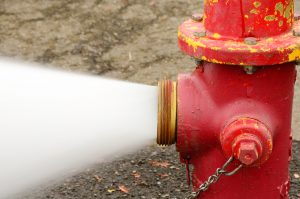 imagine what would happen if in the heat of an emergency, a fireman hooked up the hose to the hydrant and it failed? That’s why municipalities perform regular inspection and maintenance on “public” fire hydrants. imagine what would happen if in the heat of an emergency, a fireman hooked up the hose to the hydrant and it failed? That’s why municipalities perform regular inspection and maintenance on “public” fire hydrants.
However, you may also have fire hydrants installed on your private property which are considered yours to inspect and maintain. The National Fire Protection Association (NFPA) has a standard that is adopted by many village ordinances and outlines the inspection, testing and maintenance requirements that need to be followed.
In other words, to ensure the health of the overall water supply system and the proper functioning of the hydrants located most closely to your business, it is your responsibility to maintain any fire hydrants on your private property.
Recently, the Village of Downers Grove began notifying building owners who have hydrants on their private property of any need for routine inspection, testing and maintenance. The Village is setting an aggressive schedule for ensuring all municipal water mains and hydrants receive the proper testing as outlined by the NFPA standard by September 1. Property owners can contact any commercial fire protection company they want to complete the inspection.
If you need fire hydrant service, Total Fire & Safety can help! We are a trusted, full-service provider of commercial fire protection that has been serving the Village of Downers Grove for more than 30 years.
Our fire hydrant service includes:
- Full inspection
- Any needed repair
- Reporting to DGFD and all third parties (www.theComplianceEngine.com) as directed by the Fire Department
If you are not sure of whether your fire hydrants are in compliance, you can check with the Village of Downers Grove Water Department at 630-434-5460 or the Downers Grove Fire Department at 630-434-5983.
If you would like to schedule your hydrant service today, contact us at 630-960-5060.
Testing ensures the proper flow and flushes debris from the hydrant.
Category: Business Safety, Fire News, Total Fire and Safety Tags: downers grove, downers grove fire, downers grove il, fire hydrant inspection, fire hydrant safety, fire hydrants, fire hydrants il | Comments Off on Downers Grove Businesses: Your Fire Hydrants May Need Inspection
-
May 30, 2018 by Total Fire and Safety
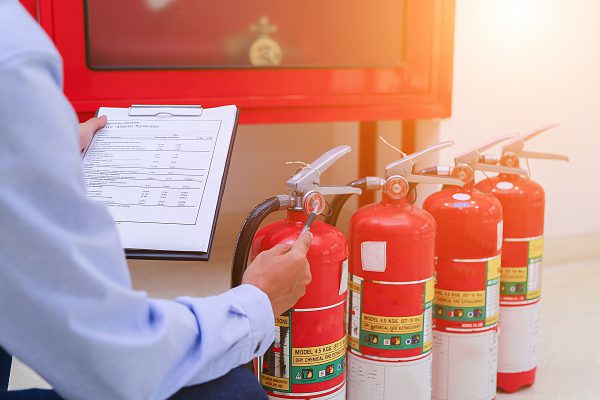
Most companies understand the mandate to have regular fire extinguisher inspections but many wonder why on earth a company could actually fail these inspections. After all, a fire extinguisher is rarely used so how can it need service?
Chances are you see a fire extinguisher every day, but how closely do you look at it? Even one dent in the tank can change the outcome. According to the NFPA, nearly 30 percent of fire extinguishers are not in proper working order. Total Fire and Safety’s twelve-point check can ensure your company’s compliance. However, there are five main reasons why companies fail a fire extinguisher inspection.
1. Unseen Damage– Corrosion or damage can occur over time in hard to see areas of the extinguisher, for example, rust within the tank. That is when a professional steps in and inspects the extinguisher inside and out. TFS will visually examine the extinguisher making sure it is free of dents, rust, or other hazards.
2. Potential Hose Blockage– Debris can clog the hose or deterioration of the O-rings can occur over time, rendering a fire extinguisher useless in an emergency. TFS will remove the hose completely to check for irregularities.
3. Possible Leaks– Whether large or small, a leak will cause the fire extinguisher to be inoperable. Anyone can check the pressure gauge to determine if there is a leak. However, if there is no pressure gauge, you will need a professional. TFS will confirm the compression in the tank.
4. Wear/Fading of Labels– Labels are vital when fighting a fire because they contain instructions on how to use the extinguisher. They also provide important information about the device’s maintenance history, which is needed by inspection professionals. Once your fire extinguisher inspection is complete, the labels will be updated, and an additional certification tag will be attached.
5. Recharging Needed– Once a fire extinguisher is used, even partially, it will need to be recharged immediately. If you fail to recharge the extinguisher, it will fail you in a fire.
Although these are common reasons companies fail fire extinguisher inspections, there are other possible hazards not listed. It is important to stay up-to-date with your fire extinguisher inspections. The NFPA requires inspection every month and maintenance every year by a professional. In addition, a stored pressure extinguisher requires internal maintenance every six years and a hydrostatic test every 12 years.
It takes a minute for a fire to spread and cause irreparable damage to your company—the same amount of time it takes to schedule a fire extinguisher inspection!
Total Fire and Safety can inspect your fire extinguishers to ensure they are unfailingly ready to fight fire at a moment’s notice. We also provide onsite training for your employees, including hands-on practice in the use of a fire extinguisher. Give us a call today at 630.960.5060.
Category: Business Safety, Fire code violation, Fire Equipment Inspections, Fire Extinguishers, Fire Extinguishers, Fire Safety, NFPA Compliance, Total Fire and Safety Tags: equipment, Extinguisher, fire and safety equipment, fire and safety needs, Fire Extinguisher, fire extinguisher inspections, fire safety, safety, Total Fire & Safety, Total Fire and Safety | Comments Off on Why Companies Fail Fire Extinguisher Inspections
-
March 21, 2018 by admin
Join us for the 2018 Fire Safety Symposium
at Total Fire & Safety!
Register below! Space is limited!
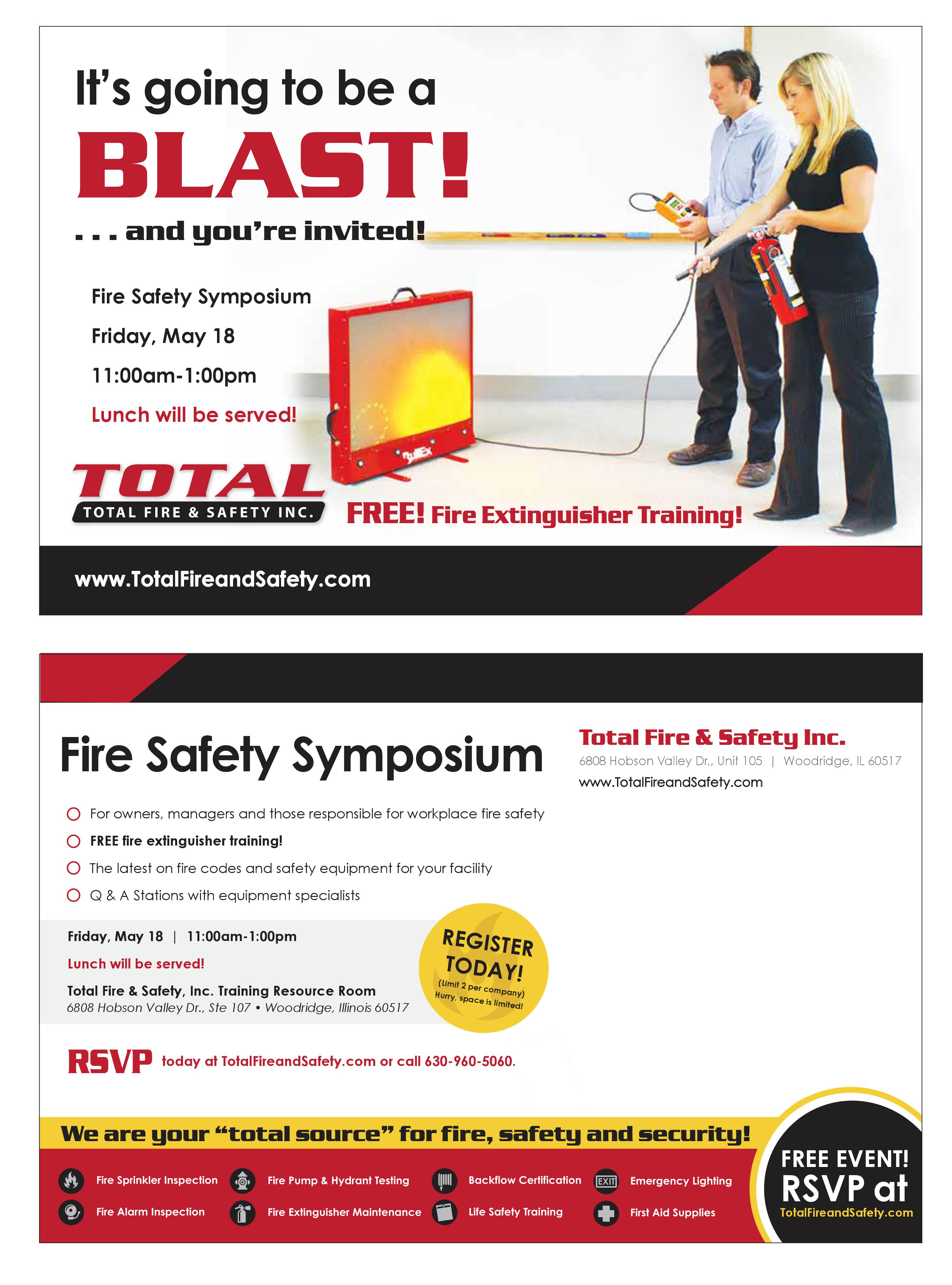
Category: Business Safety, Client Events, Fire Extinguishers, Fire Extinguishers, Fire News, Fire Safety Tags: commercial fire safety, employee training, fire and safety equipment, fire and safety solutions, Fire Extinguisher, fire safety, fireextinguisher, Fireextinguishertraining, Total Fire & Safety, Total Fire and Safety, training | Comments Off on Fire Safety Symposium
|

|
|
|
|
|
|

 Facebook
Facebook
 Instagram
Instagram
 LinkedIn
LinkedIn






 imagine what would happen if in the heat of an emergency, a fireman hooked up the hose to the hydrant and it failed? That’s why municipalities perform regular inspection and maintenance on “public” fire hydrants.
imagine what would happen if in the heat of an emergency, a fireman hooked up the hose to the hydrant and it failed? That’s why municipalities perform regular inspection and maintenance on “public” fire hydrants. 

